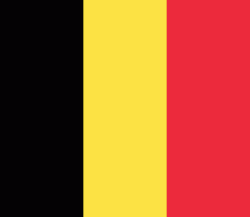Martelange
Martelange (Martelingen; Maartel ; Måtlindje) is a municipality of Wallonia located in the province of Luxembourg, Belgium.
On 1 January 2007 the municipality, which covers 29.67 km2, had 1,584 inhabitants, giving a population density of 53.4 inhabitants per km2. Besides Martelange itself, the municipality includes the villages of Grumelange and Radelange.
For some 1.8 km, the N4 Brussels to Arlon road, which passes through the village, forms the border with the Grand Duchy of Luxembourg. Because fuel, tobacco, and alcohol taxes are lower in Luxembourg than in Belgium, the eastern, Luxembourgish side of this stretch of road has become lined with numerous petrol stations and liquor stores.
Between 1830 and 1947, the town was a major slate quarrying centre, though the industry has now completely disappeared.
On August 21, 1967, a French tanker lorry containing 45 000 litres of Liquefied petroleum gas suffered from failing brakes while driving downhill. It exploded in the middle of the village, killing 22 people and injuring 54. Dozens of houses were completely destroyed.
On 1 January 2007 the municipality, which covers 29.67 km2, had 1,584 inhabitants, giving a population density of 53.4 inhabitants per km2. Besides Martelange itself, the municipality includes the villages of Grumelange and Radelange.
For some 1.8 km, the N4 Brussels to Arlon road, which passes through the village, forms the border with the Grand Duchy of Luxembourg. Because fuel, tobacco, and alcohol taxes are lower in Luxembourg than in Belgium, the eastern, Luxembourgish side of this stretch of road has become lined with numerous petrol stations and liquor stores.
Between 1830 and 1947, the town was a major slate quarrying centre, though the industry has now completely disappeared.
On August 21, 1967, a French tanker lorry containing 45 000 litres of Liquefied petroleum gas suffered from failing brakes while driving downhill. It exploded in the middle of the village, killing 22 people and injuring 54. Dozens of houses were completely destroyed.
Map - Martelange
Map
Country - Belgium
 |
 |
| Flag of Belgium | |
Belgium is a sovereign state and a federal constitutional monarchy with a parliamentary system. Its institutional organization is complex and is structured on both regional and linguistic grounds. It is divided into three highly autonomous regions: the Flemish Region (Flanders) in the north, the Walloon Region (Wallonia) in the south, and the Brussels-Capital Region. Brussels is the smallest and most densely populated region, as well as the richest region in terms of GDP per capita. Belgium is also home to two main linguistic communities: the Flemish Community, which constitutes about 60 percent of the population, and the French Community, which constitutes about 40 percent of the population. A small German-speaking Community, numbering around one percent, exists in the East Cantons. The Brussels-Capital Region is officially bilingual in French and Dutch, although French is the dominant language.
Currency / Language
| ISO | Currency | Symbol | Significant figures |
|---|---|---|---|
| EUR | Euro | € | 2 |
| ISO | Language |
|---|---|
| NL | Dutch language |
| FR | French language |
| DE | German language |















